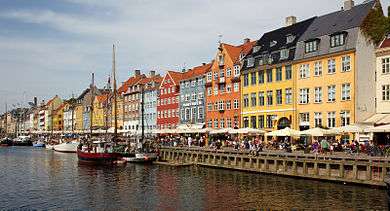Nyhavn

Nyhavn (Danish pronunciation: [ˈnyhɑʊ̯ˀn]; New Harbour) is a 17th-century waterfront, canal and entertainment district in Copenhagen, Denmark. Stretching from Kongens Nytorv to the harbour front just south of the Royal Playhouse, it is lined by brightly coloured 17th and early 18th century townhouses and bars, cafes and restaurants. The canal harbours many historical wooden ships.
History
Nyhavn was constructed by King Christian V from 1670 to 1673, dug by Swedish prisoners of war from the Dano-Swedish War 1658–1660. It is a gateway from the sea to the old inner city at Kongens Nytorv (King's Square), where ships handled cargo and fishermens' catch. It was notorious for beer, sailors, and prostitution. Danish author Hans Christian Andersen lived at Nyhavn for some 18 years.
The first bridge across Nyhavn opened on 6 February 1875. It was a temporary wooden footbridge.[1] It was replaced by the current bridge in 1912.[2]
As ocean-going ships grew larger, Nyhavn was taken over by internal Danish small vessel freight traffic. After World War II land transport took over this role and small vessel traffic disappeared from the Port of Copenhagen, leaving Nyhavn largely deserted of ships.
In the mid-1960s, the Nyhavn Society (Danish: Nyhavnsforeningen) was founded with the aim of revitalising the area. In 1977, Nyhavn was inaugurated as a veteran ship and museum harbour by Copenhagen’s Lord Mayor Egon Weidekamp. In 1980 Nyhavn quay was pedestrianised; it had been used as a parking area in the previous years which had coincided with a dwindling of harbour activities. [3] Since then it has become a popular spot for tourists and locals alike, serving the function of a square according to architects Jan Gehl and Lars Gemzøe.[3]
Buildings

The northern side of Nyhavn is lined by brightly coloured townhouses built with wood, bricks, and plaster. The oldest house, at No. 9, dates from 1681.
Between 1845 and 1864, Hans Christian Andersen lived at No. 67, where a memorial plaque now stands.
The southern side of Nyhavn has lavish mansions lining the canal, including Charlottenborg Palace at the corner of Kongens Nytorv.
Veteran Ship and Museum Harbour
Nyhavn Veteran Ship and Museum Harbour, occupying the inner section of Nyhavn, between the Nyhavn Bridge and Kongens Nytorv, is lined with old ships. From the foundation of the heritage harbour in 1977, the south side of the canal has been reserved for museum ships owned by the Danish National Museum, which received a donation of carefully restored ships from A. P. Møller, while the northern side of the canal was put at the disposal of the Nyhavn Society and privately owned, still usable wooden ships. Harbor ships include:
- Lightvessel XVII Gedser Rev - lightvessel built in Odense in 1895, in operation until 1972, then acquired by the National Museum and now serving as a museum ship.
- Svalan af Nyhavn - galease built in Jungfrusund in 1924
- Anna Møller - galease built in Randers in 1906
- MA-RI - purpose-built smuggling ship built in 1920; boarded by custom authorities off Elsinore with smuggling goods aboard in 1923, then confiscated and sold on auction, then operated both as a fishing vessel and as a ferry between Poland and Bornholm, again as a smuggling vessel.
- Mira - two-masted schooner built in Fåborg in 1898, considered one of the finest ships of the Danish small vessel traffic of the time. For many years it transported chalk from Stevns. The first ship on the north side of Nyhavn, coming from Kongens Nytorv.
- The Boat Theatre - a lighter-type barge built in Copenhagen in 1898, since 1972 operated as a theatre boat.
The Memorial Anchor

The great Memorial Anchor (Danish: Mindeankeret) at the end of Nyhavn, where it meets Kongens Nytorv, is a monument commemorating the more than 1,700 Danish officers and sailors in service for the Navy, merchant fleet or Allied Forces, who sacrificed their lives during World War II. The Anchor was inaugurated in 1951, replacing a temporary wooden cross erected on the spot in 1945, and has a plaque with a monogram of King Frederik VII on it. The Memorial Anchor is from 1872 and was used on the Frigate Fyn (Funen), which was docked at Holmen Naval Base during the Second World War. Every year on May 5 – Denmark’s Liberation day 1945 – an official ceremony is held to honour and commemorate the fallen at the Memorial Anchor.[4]
Bars and restaurants
Along its northern, sunnier side, Nyhavn is lined with bars and restaurants facing the harbor. Nyhavn serves as a hub of canal tours.
Transport
Kongens Nytorv metro station is located at the end of Nyhavn, though situated at the far end of the namesake square outside Magasin du Nord. The station is served by both lines M1 and M2 of the Copenhagen Metro.
The Copenhagen Harbour Buses has a stop at the mouth of Nyhavn. All four routes of the harbour buses, Routes 901, 902, 903 and 904, stop at the bus stop next to the Royal Playhouse.
See also
References
- ↑ "Nyhavns Bro under nedbrydning". Københavns Museum. Retrieved 2012-01-02.
- ↑ "Nyhavns historie" (in Danish). Nyhavns Skipperlaug. Retrieved 2011-01-02.
- 1 2 Gehl, Jan; Gemzøe, Lars (1996). Public Spaces, Public Life, Copenhagen. The Danish Architectural Press and the Royal Danish Academy of Fine Arts. p. 20. ISBN 877 407 305 2.
- ↑ "Nyhavn". Copenhagen Portal. Retrieved 2009-08-03.
External links
| Wikimedia Commons has media related to Nyhavn. |
Coordinates: 55°40′47″N 12°35′26″E / 55.67972°N 12.59056°E